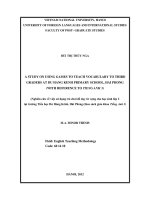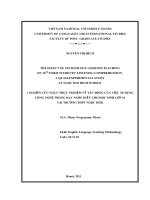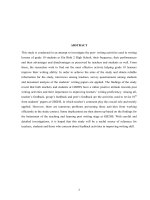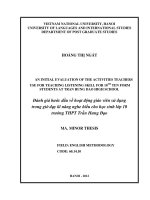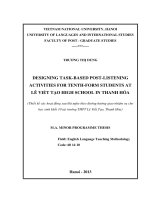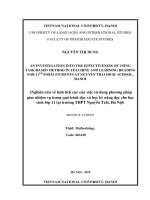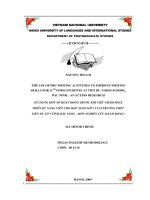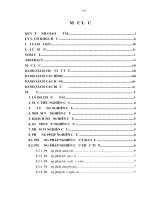Nghiên cứu thực nghiệm về tác động của việc áp dụng công nghệ trong dạy nghe hiểu cho học sinh lớp 10 tại trường THPT Ngọc Hồi
Bạn đang xem bản rút gọn của tài liệu. Xem và tải ngay bản đầy đủ của tài liệu tại đây (3.87 MB, 82 trang )
VIETNAM NATIONAL UNIVERSITY, HANOI
UNIVERSITY OF LANGUAGES AND INTERNATIONAL STUDIES
FACULTY OF POST- GRADUATE STUDIES
NGUYỄN THỊ BÍCH
THE EFFECT OF TECHNOLOGY-ASSISTED TEACHING
ON 10
TH
FORM STUDENTS’ LISTENING COMPREHENSION:
A QUASI-EXPERIMENTAL STUDY
AT NGOC HOI HIGH SCHOOL
( NGHIÊN CƯ
́
U NGU
̣
Y THƯ
̣
C NGHIÊ
̣
M VÊ
̀
TA
́
C ĐÔ
̣
NG CU
̉
A VIÊ
̣
C A
́
P DU
̣
NG
CÔNG NGHÊ
̣
TRONG DA
̣
Y NGHE HIÊ
̉
U CHO HO
̣
C SINH LƠ
́
P 10
TI TRƯNG THPT NGC HI)
M.A. Minor Programme Thesis
Field: English Language Teaching Methodology
Code: 60 14 10
Hanoi, 2011
VIETNAM NATIONAL UNIVERSITY, HANOI
UNIVERSITY OF LANGUAGES AND INTERNATIONAL STUDIES
FACULITY OF POST- GRADUATE STUDIES
NGUYỄN THỊ BÍCH
THE EFFECT OF TECHNOLOGY-ASSISTED TEACHING
ON 10
TH
FORM STUDENTS’ LISTENING COMPREHENSION:
A QUASI-EXPERIMENTAL STUDY
AT NGOC HOI HIGH SCHOOL
( NGHIÊN CƯ
́
U NGU
̣
Y THƯ
̣
C NGHIÊ
̣
M VÊ
̀
TA
́
C ĐÔ
̣
NG CU
̉
A VIÊ
̣
C A
́
P DU
̣
NG
CÔNG NGHÊ
̣
TRONG DA
̣
Y NGHE HIÊ
̉
U CHO HO
̣
C SINH LƠ
́
P 10
TI TRƯNG THPT NGC HI)
M.A. Minor Programme Thesis
Field: English Language Teaching Methodology
Code: 60 14 10
Supervisor : LAM THI PHUC HAN, M.A.
Hanoi, 2011
vi
LIST OF ABBREVIATIONS
CALL: Computer Assisted Language Learning
EFL: English as a Foreign Language
ELT: English Language Teaching
ESL: English as a Second Language
IT: Information Technology
NHHS: Ngoc Hoi High School
vii
LIST OF TABLES AND FIGURES
Page
Table 1: Pre-test descriptive statistics………………………………………
25
Table 2: Post-test descriptive statistics……………………………………….
26
Table 3: Part I of pre-test and post-test descriptive statistics of the
experimental group………………………………………………………….
27
Table 4: Part II of pre-test and post-test descriptive statistics of the
experimental group…………
27
Table 5: Part III of pre-test and post-test descriptive statistics of the
experimental group…
28
Fingure 1: Students’ assessment on the importance of the Powerpoint
presentations in teaching and learning listening skill………………………
29
Fingure 2: Students’ assessment on effectiveness of the Powerpoint
presentations in teaching and learning listening skill………………………
29
Figure 3: Students’ assessment of the effectiveness of the Powerpoint
presentations in developing listening sub-skills ( from sub-skill 1 to
sub-skill 5)…………………………………………………………………
30
Fingure 4: Change in percentage of students’ comprehension after the
application of Powerpoint presentations ……………………………………
32
Fingure 5: Change in percentage of students’ retention after the application
of Powerpoint presentations………………………………………………….
33
Table 6: Students’ opinions about the advantages of the Powerpoint
presentations in teaching and learning listening skill………………………
34
viii
TABLE OF CONTENTS
Page
Declaration……………………………………………………………………
iii
Acknowledgements…………………………………………………………
iv
Abstract………………………………………………………………………
v
List of abbreviations………………………………………………………….
vi
List of tables and figures……………………………………………………
vii
PART A: INTRODUCTION……………………………………………….
1
1. Rational for the study……………………………………………………
1
2. Objectives and significance of the study…………………………………
2
3. Research questions…………………………………………………………
2
4. Scope of the study………………………………………………………….
3
5. Methods of the study………………………………………………………
3
6. Organization of the study………………………………………………….
4
PART B: DEVELOPMENT………………………………………………
5
CHAPTER 1: LITERATURE REVIEW………………………………….
5
1.1. Listening comprehension………………………………………………
5
1.1.1. Definition of listening comprehension………………………………
5
1.1.2. The importance of listening in second language learning……………
6
1.1.3. Some challenges of to the learners…………………………………….
7
1.1.4. Listening stages………………………………………………………
8
1.1.4.1. Pre-listening stage……………………………………………………
8
1.1.4.2. While-listening stage………………………………………………
9
1.1.4.3. Post-listening stage………………………………………………….
10
1.2. Technology-assisted teaching……………………………………………
11
1.2.1. Definition of technology- assisted teaching……………………………
11
1.2.2. Role of technology in language teaching……………………………
11
1.2.3. Previous studies………………………………………………………
13
1.2.4. The application of Powerpoint in designing the activities of a listening
ix
lesson…………………………………………………………………………
15
1.2.4.1. Pre-listening………………………………………………………….
15
1.2.4.2.While –listening………………………………………………………
16
1.2.4.3. Post- listening………………………………………………………
17
CHAPTER 2: METHODS OF THE STUDY …………………………….
18
2.1 Background of the study………………………………………………….
18
2.1.1. Ngoc Hoi school and its teaching and learning conditions…………….
18
2.1.2. The syllabus……………………………………………………………
19
2.2. Methods of the study……………………………………………………
20
2.2.1. The quasi-experimental method………………………………………
20
2.2.1.1. Definition of the quasi-experimental method………………………
20
2.2.1.2. Rational of using a quasi-experimental method……………………
20
2.2.2. The subjects …………………………………………………………
21
2.2.3. Data collecting instruments……………………………………………
21
2.2.3.1. Pre and post-tests ……………………………………………………
22
2.2.3.2. Questionnaires……………………………………………………….
23
2.2.4. Procedures……………………………………………………………
23
2.2.4.1. Before the experimental treatment…………………………………
24
2.2.4.2. During the experimental treatment ………………………………….
24
2.2.4.3. After the experimental treatment……………………………………
24
CHAPTER 3: DATA ANALYSIS AND DICSUSSION…………………
25
3.1. The findings of the study………………………………………………
25
3.1.1. The results of listening tests……………………………………………
25
3.1.1.1. The results of pre-tests scores of the two groups ……………………
25
3.1.1.2. The results of post-tests scores of the two groups…………………
26
3.1.2. The results of the questionnaire………………………………………
28
3.1.2.1. Students’ assessment on the importance and the effectiveness of the
Powerpoint presentations in teaching and learning listening skill…………
29
3.1.2.2. Students’ assessment on their listening skill improvement………….
32
x
3.1.2.3. The benefits of the Powerpoint presentations in teaching and
learning listening skill………………………………………………………
34
3.2. Discussions on the study results…………………………………………
35
3.3. Summary…………………………………………………………………
37
PART C: CONCLUSION…………………………………………………
38
1. Summary of the main findings and conclusion……………………………
38
2. Pedagogical implications………………………………………………….
38
3. Limitations and suggestions for further research…………………………
39
REFERENCES………………………………………………………………
41
APPENDICES……………………………………………………………….
I
APPENDIX 1: Pre and post tests ………………………………………
I
APPENDIX 2: Questionnaire ………………………………………
VII
APPENDIX 3: Detailed scores of the pre and post tests…………………
X
APPENDIX 4: Lesson plans………………………………………………
XVI
1
PART A: INTRODUCTION
This part is comprised of six sections including the rationale for the study, the
objectives and significance of the study, the research questions, the scope of the study,
the methods used in the study and the organization of the study.
1. Rationale for the study
Due to the current status of English as a global language of science, technology, and
international relations, Vietnam considers the teaching of English a major educational
priority. Teachers of English have made great efforts to make use of the multimedia
technology and to integrate this technology in their classroom teaching to improve their
English language teaching.
Applying Information Technology (IT) into teaching and learning is one of the
essential tasks of the National Education Service at present. IT application to English as a
second language (ESL) teaching is, therefore, a need and the most important one to make
the more effectiveness. The advantages of using the technology-assisted teaching in the
language classroom have been recognized by many researchers in applied linguistics. The
main one is considered to be its ability to present and immerse learners into complete
communicative situations (Lonergan, 1984). According to Hutchen (2004), the use of
technology-assisted instruction is widely applied in education to improve student
performance, learning and satisfaction. Another advantage is the ability of the technology-
assisted teaching to cover non-verbal aspects of communication and its cross-cultural
comparison potential (Stempleski & Tomalin, 1990). In addition, using IT tools in the
classroom allows differentiation of teaching and learning according to students‟ abilities,
learning styles and personalities.
To teach English more effectively, teachers and students need to approach various
types of IT tools such as computers, overhead-projectors, multimedia projectors and some
popular softwares in teaching as: Power point, Word processor,Window media. The
powerful IT tools, which can help teachers to expand the four walls of the tradditional
classroom and rebuild the class with many useful controlled and free activities for
communicative competence, are increasing in both quality and quantity.
I myself enjoy teaching English, especially teaching listening skill with the help of IT
tools and I find that students are interested in the lessons with the application of IT. I have
2
also tried using the technology-assisted teaching for the teaching of listening skill and
found it rather promising. However, there have still been some questions such as how
much does the technology-assisted teaching actually motivate students to learn? To what
extent does it affect students‟ listening comprehension in classroom? How should the
technology-assisted teaching be used in listening lessons to improve students‟ listening
comprehension?
These questions motivated me to carry out the study on “The effect of technology-
assisted teaching on 10th form students’ listening comprehension”. With this study, the
researcher mainly focused on carrying out a quasi-experimental research to investigate the
effectiveness of using the technology-assisted teaching on improving students‟ listening
competence.
The technology-assisted teaching or IT tools, which are mentioned in this study,
are computers, Multimedia Projectors to show the Powerpoint presentations. In applying
IT, almost teachers in the author‟s school context understand IT as the use of PowerPoint,
which is introduced to them in the course of applying IT in foreign language teaching.
2. Objectives and significance of the study
The first and foremost aim of the study is to find out the effects of technology-assisted
teaching on improving the students‟ performance in English listening skill, so as to change
their attitude to listening as well as to enhance the students‟ participation in English
listening classes of the 10
th
form students at Ngoc Hoi High School (NHHS). The second
one is to discover the benefits of technology-assisted teaching that students perceive in
listening comprehension. Last but not least important, some effective ways for teaching
listening comprehension are recommended with a view to improve students‟ listening
comprehension.
The study is done in a hope that it will help better the situation of teaching and
learning English listening comprehension at NHHS. Thus, it will help enhance students‟
English competence.
3. Research questions
To achieve the aims which are mentioned above, this study was designed to test the
following hypothesis:
3
- Hypothesis: Technology-assisted teaching helps to improve students‟ listening
comprehension.
In order to draw the conclusion on how hypothesis would be accepted, the following
research questions are raised:
1, To what extent does technology- assisted teaching help to improve students’ listening
comprehension as measured by the difference between their pretest and posttest scores ?
2, How much do students perceive the benefits of technology- assisted teaching to their
listening comprehension ?
It is hoped that the findings of the study will be of benefit to the teachers at NHHS,
especially those who are engaged in teaching listening. The study can highlight some
effects that technology- assisted teaching can bring about to improve students‟ listening
comprehension and some benefits of technology- assisted teaching that students perceive
in listening comprehension. The findings of the study will also contribute to our
understanding of the role of technology in language teaching and learning in general.
4. Scope of the study
The research limits its scope to the teaching of listening skill in English using the
regular English text book 10 and to its participants of 10
th
form students at NHHS. The
choice of participants is simply a matter of convenience the researcher is teaching
listening for 10
th
form students at NHHS.
In this study, the term “technology” is used in a very narrow sense. In fact,
„technology‟ in this study refers to the use of the Powerpoint as a support to the teaching
and learning of listening comprehension in the researcher‟s school. She is fully aware that
technology is not synonymous with the Powerpoint, but she decided to use the term in this
restricted sense because this is a common way that technology is meant in her context.
5. Method of the study
To realize the objectives of the study , the main research method employed in this
study is a quasi- experimental design which according to Seliger and Shohamy (1989:136)
involves the three basic components of experiments: the population (the 10
th
form
students at NHHS), the treatment (Technology-assisted teaching) and the measurement of
the treatment (t-test). The data for the study were obtained through the following
instruments:
4
* Pre and post-tests which were designed by the researcher to find out the students‟
ability in listening comprehension.
* The questionnaires which were also delivered to the students taking part in the
experiment as a complementary tool to discover the benefits of technology-assisted
teaching (the benefits of the application of Powerpoint presentations) that students
perceive in listening comprehension.
6. Organization of the study
The thesis consists of three main parts:
Part A is the introduction, which presents an overview of the study with the rationale
for the research, the aims and the research questions of the study. It also narrows the
scope, presents the research method and outlines the content of the study.
Part B is the development, which includes three chapters as follows:
*Chapter 1 is the Literature review. This chapter presents all the related theoretical
background that precedes and necessitates the information of the research.
*Chapter 2 describes the research methods used in the study with some necessary
components.
*Chapter 3 is devoted to a detailed description of of data analysis and thorough
discussion of the findings of the study. In this chapter some explaination and
interpretations of the findings are explored.
Part C is the conclusion which presents the study conclusions and teaching
implications. Besides, it also offers the limitations and suggestions for further study.
5
PART B: DEVELOPMENT
CHAPTER 1: LITERATURE REVIEW
In this chapter, all the related theoretical background that precedes and necessitates
the information of the research is presented. There are two main parts: Listening
comprehension and Technology-assisted teaching. The first part deals with definition of
listening comprehension, the importance of listening in second language learning, some
challenges of listening comprehension and stages in teaching listening, and the second one
refers to definition of Technology-assisted teaching, roles of Technology-assisted
teaching, some previous studies on the effect of Technology on students‟ listening
comprehension and the application of Powerpoint Presentation in teaching listening.
1. 1. Listening comprehension
1.1.1. Definition of listening comprehension
Enlish listening is now well recognized as a crucial role in language learning and
communication. Over the last two decades, with a new wave of interest in the
development of communicative competence in language teaching, listening
comprehension skills have ever received much more attention in language teaching
classrooms. Researchers have different views on the definition of listening
comprehension:
Underwood (1989: 1) puts a simple and easy-to-understand definition. According
to her, listening “is the activity of paying attention to and trying to get meaning from
something we hear.” Underwoord emphasizes the consciousness of listeners by using the
phrase “paying attention”. Besides, listening here does not stress the word level but the
meaning of the whole utterance.
Listening comprehension is defined by O‟Malley & Chamot (1989: 420) as
follows: “Listening comprehension is an active and conscious process in which the
listener constructs meaning by using cues from contextual information and existing
knowledge, while relying upon multiple strategic resources to fulfil the task requirement”.
Buck (2001: 247) provide a broader definition of listening comprehension:
“Listening is a complex process in which the listeners takes the incoming data, an
acoustic signals, and interprets it based on a wide variety of linguistic and non-linguistic
knowledge. The linguistic knowledge includes knowledge of phonology, lexis, syntax,
6
semantics, discourse structure, pragmatics and sociolinguistics. The non-linguistic
knowledge includes knowledge of the topic, the context and general knowledge about the
world and how it works”
Therefore, the concept of listening comprehension can be broadly defined as
everything that improves on the human processing which mediates between sounds and
the construction of meaning when listeners are expected to attend to what they hear to
process it, to comprehend, to interpret, to evaluate and to respond to the incoming data. In
order to do all these things, they have to get envolved in the process and become active
listeners.
From the concept of listening comprehension above, in this study the students‟
listening comprehension is their performance on the listening tests.
1.1.2. The importance of listening in second language learning
English listening plays quite an important role because the key to acquire a
language is to receive language input. In Rost‟s point of view, teaching listening is an
important part of L2 teaching because the learners are provided with input that helps them
able to learn better. Listening instruction is also a good chance for the learners to interact
and learn spoken language as well as authentic spoken language. Besides, Teachers can
provide the learners with listening exercises to draw their attention to new form in the
language such as vocabulary, grammar, interaction patterns. ( Rost, 1991: 141) It is true
that listening is of great essence not only as a respective skill but also to the development
of the language proficiency. Listening skill is obviously a necessary preliminary to the
success of the language learning process.
Moreover, according to the second language acquisition theory, language input is
the most essential condition of language acquisition. As an input skill, listening plays a
crucial role in students‟ language development. Krashen (1985) argues that people acquire
language by understanding the linguistic information they hear. Thus language acquisition
is achieved mainly through receiving understandable input and listening ability is the
critical component in achieving understandable language input. Rost (1994) also
pinpointed the importance of listening in the language classroom as the supplier of the
input for students. Without comprehension input at the right level, learning cannot work
well. In additions, students spend most of their time listening to the teacher‟s lecture.
7
Nichols and Stevens (see Elkhafaifi, 2005: 505) reported that among four language skills
in language learning: listening is the most frequently used skill: 45% is devoted to
listening, 30% to speaking, only 16% to reading and a mere 9% to writing. Therefore,
listening is a fundamental and vital skill in the acquisition of languages (Nunan, 2002).
Thus, it is of vital importance that students should be taught to listen effectively and
critically. Given the importance of listening in language teaching and learning, it is
essential for language teachers to help students become effective listeners.
1.1.3. Some challenges of listening to the learners
Listening is usually a hard skill to master in one‟s own language as well as in
second language acquisition.There have been different views about factors that affect
listening comprehension:
According to Brown and Yule, there are four main groups of factors that cause
difficulty in listening comprehension. They are, in turns, the speaker, the listener, the
content and support.
“ there are four main groups of factors that cause difficulty in listening
comprehension. These are the speaker (that includes the numbers of speakers, the
speaker’s speed, and the speaker’s accents); the listeners (this consists of the roles
of the listeners, the level of response required and the listener’s interest in the
subject): the content (vocabulary, grammar, information structure and background
knowledge); and support (whether there are pictures, diagrams and visual aids ).
(Brown and Yule (1983:74)
Mary Underwood (1989: 16-19) draws out seven problems learner may encounter
when learning to listen: fast speed; unrepeated thing; the listeners‟ limited vocabulary;
failure to recognize the “signals”; interpretation; concentrate; and learning habit.In
addition, unfamiliar topic can interfere with the learner‟s concentration which is a major
problem in listening activity. According to Underwood (1989: 19), “If students find the
topic interesting, they will find concentration easier.” Interesting topic makes listening
activities enjoyable; students become engaged in classroom activities; therefore, it is a
good way to minimize the harmful effect.
Restriction of vocabulary is also the common problem for the learners. Some
words in the listening text may be the new words for them, which may cause dificulty for
8
the learners‟ comprehension of the text. Just as Underwood (1989:17) said, “For people
listening to a foreign language, an unknown word can be like a suddenly dropped barrier
causing them to stop and think about the meaning of the word and thus making them miss
the next part of the speech”.
The lack of background knowledge, which is also called prior knowledge or
schemata, may impede student performance. As suggested by Underwood (1989: 19),
students who are unfamiliar with the context may have considerable difficulty in
interpreting the words they hear even when they can understand their „surface‟ meaning.
In short, the problems students may encounter in listening comprehension are
many and various. As a result, the teacher should take into considerations the challenges
mentioned above in order to assist the students to overcome the difficulties in listening
comprehension and gain success in their listening. Powerpoint presentation can be applied
as an effective tool here.
1.1.4. Listening stages
Underwood (1989: 30-74) indicates that the teaching of a listening lesson is
divided into three main stages: pre-listening, while-listening and post-listening. The three-
stage listening lesson model is usually used by many teachers as it is very useful in
teaching listening. Each stage has its own purposes, activities and time allocation.
1.1.4.1. Pre-listening stage
“Starting lessons with pre-listening activities brings a host of benefits to language
learning.” (Boyle, 1984:24). Inevitably, pre-listening stage plays a vital role in the whole
process of teaching. Pre-listening stage is aimed at preparing students to listen and think
about what they are going to hear. Time allocation for this stage should be short-five or
ten minutes. According to Baker and Westrup, and Lewis and Hill, the purposes of pre-
listening phase are:
- to introduce and arouse interest in the topic
- to promote an active and flexible learning environment
- to help increase learners‟ motivation for learning
- to motivate learners by giving a reason for listening
- to provide some language preparations for the text
9
(Baker and Westrup ,2000;233 and Lewis & Hill, 1992; 195)
During this stage, teachers may use some activities such as: teacher giving
background information, the students reading something relevant, the students looking at
pictures, having discussions about the topic/situation, doing a question and answer session
or written exercises, following instruction for the while-listening activity and taking
consideration of how the while-listening will be done (Underwood, 1989: 31). These
activities may provide an oppotunity for students to gain some knowledge which help
them to follow the listening text more easily.
1.1.4.2. While-listening stage
This stage is the main part of a listening lesson aiming at facilitating learners‟
listening and checking their comprehension. Time allocation for this stage is nearly two
thirds of the whole lesson. According to Underwood (1989: 45-48), while listening
activities are what students are asked to do during the time they are listening to the text.
The purpose of while listening activities is to help learners develop the skill of eliciting
messages from spoken language. As developing the skills of listening for comprehension
is the aim, while-listening activities must be chosen carefully. The activities of this stage
have the following requirements. First, they should be interesting and carefully chosen to
help students feel like listening, so that they may want to carry out the activites. Second,
they should be things which most students can do.Thus, teachers should provide other
activities from textbook for slower classes and move from simpler tasks (listening for
getting key words/phrases, listening for main ideas, matching, deciding on true/false
information, numbering pictures, sequencing events…) to more complicated ones
(answering MCQs, gap-filling, table/graph completing, answering information
questions…) in order to motivate students to participate in the lessons. Besides,the
instruction for these activities should be clear (rephrasing textbook instructions if
necessary).
Approriacy is considered as the main characteristic of while-listening activities.
Therefore, activities of this state should be suitable with students‟ abilities and should
relate directly to the text.
The following points should be kept in mind when planning while-listening
activities:
10
+ Decide what is and is not important to understand
+ Use predicting to encourage students to monitor their comprehension as they listen.
+ Use questions to focus students' attention on the elements of the text crucial to
comprehension of the whole.
+ Organize activities to guide listeners through the text (combine global activities such as
getting the main idea, topic, etc.)
+ Give an immediate feedback whenever possible (encourage students to examine how or
why their responses were incorrect.) (addapted from M.A minor thesis of Do, 2010)
To conclude, "good while-listening activities help learners find their way through
the listening text and build up the expectation raised by the pre-listening activities".
(Mary Underwood, 1989:46).
1.1.4.3. Post-listening stage
This is the final stage of the listening lesson with the post-listening activities done
after the listening is completed. The teacher often makes up and varies the activities for
learners to do depending on their level of English competence. This stage often lasts for
ten or fifteen minutes. The activities at this stage are aimed at helping learners to use what
they have obtained from the listening text.
According to Underwood (1989), the first purpose of post-listening activities is to
check how well the students have understood and whether they have completed the
listening tasks.The teachers may give an answer orally, show the answers on the board or
on the screen or ask students to check again the answers in the book. The second purpose
of post-listening activities is to reflect why some students have failed to understand or
miss parts of the passage. Another purpose of post-listening activities is to expand the
topic or the language of the listening text. Post-listening work can be more effective if
they are integrated with other skills like reading, writing or speaking skills. Generally,
students spend time practising designed post-listening activities in textbook, which means
summarising listening passages in spoken or written form, relating to students‟ own
experience and extending the topic to oral or written presentations. Therefore, what
students should do in this stage are:
. Doing evaluation: Students answer true–false questions or multiple-choice questions as
an evaluation of their understanding.
11
. Practising speaking: Students act out a dialogue, interview or discussion on topics
related to the text.
. Practising writing: Students write messages, postcards, letters, etc. on topics related to
the text.
The next section will refer to the Technology-assisted teaching which is applied to
teach English listening skill.
1.2. Technology-assisted teaching
This section will focus on the technology- assisted teaching. The section is
devided into four parts: the definition of technology- assisted teaching, the role of
technology in language teaching, the previous studies and the application of Powerpoint in
designing the activities of a listening lesson.
1.2.1. Definition of technology- assisted teaching
There are many ways to define the term Technology assisted-teaching. Some
teachers use this term to refer to any things that teachers can use in teaching, such as
media images, audio or digital devices. Some other educators use this term to “refer to the
application of computer or electronic equipments in the teaching and learning”
(Muffoletto, 1994:99). For the purposes of this thesis, the definition of Technology
assisted-teaching understood as educational technology which is the study and ethical
practice of facilitating learning, and improving performance by creating, using, and
managing appropriate technological processes and resources.” (AECT, 2004).
In this study, the term “technology” is used in a very narrow sense. In fact,
„technology‟ in this study refers to the use of the Powerpoint as a support to the teaching
and learning of listening comprehension. According Kisito, PowerPoint presentations
consist of a number of individual pages or "slides". The "slide" analogy is a reference to
the slide projector. Slides may contain text, graphics, sound, movies, and other objects,
which may be arranged freely. PowerPoint, however, facilitates the use of a consistent
style in a presentation using a template or "Slide Master". Kisito, F (2007:1-2)
1.2.2. Role of technology in language teaching
Information Technology in general and computers in particular, have had great
effects on the general picture of English Language Teaching. According to Hutchens
(2004:1), the use of technology can help teachers develop innovative teaching stratergies
12
that increase student learning and comprehension and it should be implemented in the
classroom. He also strongly believes that technology can be an effective tool for
conveying information and creating a rich learning environment. Hubbard and Siskin
(2004) argue convincingly for the significant promise of Computer Assisted Language
Learning (CALL) for developing learners‟ conscious knowledge of the language, for
improving listening and reading comprehension, and for improving pronunciation.
Numerous researchers have supported the use of multimedial technology for EFL
instruction ( Jonassen 2000; Kitao 1995; Kang 1999; Pino-Silva 2002,2004; Stepp-Greany
2002) (cited in Carlos A. Mayora). Their researches show that using multimedial
technology in the classroom:
+ helps teachers to deal more effectively with a large group of students.
+ makes the introducion and presentation of content more dynamic and attractive
for students.
+ increases student motivation due to the interactive nature of the activities.
+ introduces a variety of print, audio, and visual materials that match different
student learning styles and preferences.
Using a computer, a teacher can also provide students with different kinds of
learning. Garrett‟s view is that the computer can provide textual support for listening
(transcripts, glossary help, structural clues), which is particularly valuable at pre-
intermediate lever of language study where literacy and knowledge for formal language
play a much greater role in comprehension.
In Vietnam, in applying IT, almost teachers and educators understand IT as the use
of PowerPoint, which is an incredibly popular piece of software, coming with Microsoft
packages. Teachers can use Powerpoint to create presentations to help explain different
topics and supply students with many kinds of tasks. The main purpose of Power Point is
to enable the user to create dynamic, informational slide shows through the use of text,
graphics, and animation. Slide shows created with the software are often displayed on
projection screens for training, or educational presentations. Additionally, the slides can
be arranged and printed as handouts for reference.With PowerPoint, teachers can make
charts, tables, and macros, and insert images, audio, video, and other multimedia files to
support for their teaching activities. Although PowerPoint has been around for years, it
13
has just begun to spread to schools and English Language Teaching (ELT) classrooms as
more and more classrooms and teachers have access to computers and the hardware to use
PowerPoint. Therefore, PowerPoint is becoming an increasingly popular medium in ELT
in the classrooms. (adappted from Nguyen‟s minor thesis -2010).
1.2.3. Previous studies
According to Hutchen (2004:3), the use of technology-assisted instruction is
widely applied in education to improve student performance, learning and satisfaction.
The results in his study indicated that technology-assisted instruction creates a rich,
effective, and efficient learning environment which increases student performance and
learning. Many other researchers share these ideas. Garrett, N (2009:717) says that
technology does offer the potential for enormous enhancement of foreing language
learning. Liu, M (2001:23) points out that computer technology holds the promise and
potential for offering ways in which teachers can help students improve their oral and
listening skills. Kern, R (2006:189) states that the benefits of CALL have been widely
accepted and educators agree that it can be an effective instruction tool. In addition,
several educators have realized that effective use of technology can influence student
learning. Byk, J (2008:23) said: “ I find the use of technology in the classroom amazing. It
offers great visual aids as well as listening and reading inputs through power point
presentations, for instance. I believe technology offers tools to teachers if it’s well used
and we must not forget that tools without great content and interaction do not offer good
quality teaching”. Scrivener, J (2005: 18) mentions “Computer presentation programs
(Microsoft PowerPoint ) are a good way of storing and showing images and text in
unusual ways, a sort of high-tech slide show”
The M.A thesis conducted by Huong, N.T. (2010) mentioned the effectiveness of
IT in language classroom as follow:
“With the use of projectors in the language classrooms, language teachers can use
slide presentation to make their performance more interesting. Students have
reported to be highly interested in the lesson and therefore they participated
increasingly into the activities given by the language teachers. It means that students
are extremely motivated to interact during the class time, and as a result, the
language teaching becomes more effective. Motivated students are every teacher’s
dream. In this target, teachers use IT is one of the most effective ways”
14
Kisito, F (2007:1-2) says that many teachers in his school find Microsoft
PowerPoint a more powerful visual tool for aiding instruction because the program allows
the display not just of textual information but also graphic and pictorial information, both
of which facilitate retention and learning. He confirms that if you use PowerPoint smartly
and wisely to assist your teaching, you will find that it adds more dynamism to your
classroom activities, as well as tickle the interest of many students.
From the points of the previous researchers and educators about the effectiveness
of the technology applied in teaching, it is certain that application of Powerpoint
presentations in language teaching, especially the teaching of listening skill is very
necessary and useful.
1.2.4. The application of Powerpoint in designing the activities of a listening lesson
As a high school teacher, the author always tries to use the Powerpoint presentations
in teaching English, expecially in teaching listening skill. Below are some activities used
in three stages of a listening lesson: Pre-listening stage, while-listening stage and post-
listening stage. (Lesson plans: Unit11, Unit 12 and Unit 14 – Appendix 4).
1.2.4.1. Pre-listening stage
The aim of this stage is to help students to get familliar with the topic of the spoken
text, understand the background knowledge and stimulate students‟ interest by setting the
scene. Therefore, teachers can do this by pre-teaching some of the most difficult language
(new words/difficult grammar points/ structures). They can also encourage students to
make predictions about the content of the text by using games, crossword, or matching
activity.
Below are some activities used to pre-teach listening skill in unit 11 and unit 12
(English of 10
th
form) with the aid of the Powerpoint presentations.
In unit 11 (English 10
th
form) with the listening lesson is about “ National parks”,
Powerpoint sofware can be used to design some pre-listening activities in which students
look at some photographs of Cuc Phuong National Park and listen to a part of the song
(Cuc Phuong National Park) and guess the name of the place then speak about this place
using their own knowledge of the place.
15
Picture 1: Screen of pre-listening picture guessing designed with the use
of Powerpoint – unit 11
Which place do you think of when you look at these
images and listen to this part of the song
With the theme is “ Music”, in unit 12 (English 10
th
form) and the topic of listening
lesson here is “ The musician: Van Cao”, the teacher can design a crossword game about
music with the help of software Powerpoint to draw students‟ attention. Playing this
game, students can find the words down or across and guess what is related to these
words. After students are encouraged to take part in the warm-up activity to find out the
key word: Van Cao. The teacher can lead in the new lesson with some more information
about Van Cao.
Picture 2: Screent of the pre-listening crossword designed with Powerpoint –
unit 12
NEVOHTEEB
Dap an
MATYM
OCHNIRT NSGNO
SK NOCAJLEAHCIM
RAEYWENYPPAH
CISUMKLOF
1
2
3
4
5
6
16
1.2.4.2. While –listening stage
In this stage, students often listen to the text twice and do some tasks at the same time.
Therefore, with the help of Powerpoint , teachers can design many types of gap fill ( word
level, phrase level or sentence level), they needn‟t use the original tasks in the textbook.
For example, they can design the new tasks basing on the level of their students. Below is
one task in unit 11 (English 10
th
form).
Picture 3: Screen of while-listening gap fill designed with Powerpoint – unit 11
Task 1. Listen and fill in the missing information
Cuc Phuong National Park was officially opened in ________
Cuc Phuong is located _______________________________ Hanoi
In 2002, nearly ________________ visited Cuc Phuong
There are ______________different species of flora and
________ species of fauna
Nguyen Hue’s army was stationed in Quen Voi before
it made its ________________ on Thang Long
160 kilometres south west of
100,000 visitors
1960
about 2,000
surprise attack
450
With this software, teachers can also save time by showing the mistakes and the
correct answers on the screen. For some simple gaps, teachers needn‟t explain much
because they can use the marking and explaining functions. This save them more time to
do other activities.
Picture 4: Screent of while-listening True or False designed with Powerpoint- Unit 12
II. While you listen:
Task 1
: Listen and decide whether the
statements are true or false:
1. The guest of the show is Lan Huong.
2. Except for Van Cao, Quang Hung
doesn’t like any other Vietnamese musicians.
3. Quang Hung thinks some of Van Cao’ music is
very sweet and gentle.
4. “ Tien Quan Ca”, the Vietnam National Anthem,
was written in 1954.
5. Quang Hung sometimes feels proud of his country,
Vietnam, when he hears the song.
v
v
v
v
v
T
T/F
likes some
In 1944
Quang Hung
always
17
1.2.4.3. Post- listening stage
In this stage, teachers might let students practise the designed post-listening
activities in textbook, summarise listening passages in spoken or written form, relate to
students‟ own experience, and extend the topic to oral or written presentations. Basing on
the level of students, teachers can design suitable post-listening activities. For example:
Picture 5: Screen of post-listening summary designed with Powerpoint –unit 11
Work in groups. Complete the following table about
Cuc Phuong National Park.
1960
160 km south west of Hanoi
Ninh Binh, Hoa Binh,
Thanh Hoa
About 2000
450
Nearly 100,000
During the dry season( from
October to April)
Time of opening
Location
Provinces it belongs to
Number of species of flora
Number of species of fauna
Number of visitors(2002)
Best time of visiting
This table helps students a lot to present the content of listening text. Moreover, it is
easy for other students to follow the presentation.
Picture 6: Screen of post-listening summary designed with Powerpoint –unit 14
born/ 1940
played / Santos FC/ 1956
joined and won/ 3 world cups
After his retirement/ became
ambassador for the sport
played/ New York Cosmos FC
/1971-1977
III.After you listen: Talk about the Pelé’s life.
Above are some pictures illustrating the way teachers can use the Powerpoint
software to design listening activities in three stages. Due to the limited time, the author
only chose some typical ones which are useful for this research.
18
CHAPTER 2: METHODS OF THE STUDY
In this chapter, the researcher will provide some information about the background
in which the study took place, which study includes NHHS and its teaching and learning
conditions, and the syllabus. The second part of this chapter will deal with the methods of
the study including the quasi-experimental method, data collecting instruments and the
procedures of the research.
2.1. Background of the study
This section is devoted to the discussion of NHHS, where the researcher works
and does the research. In fact, the researcher will refer to the factors that play a great part
in her research such as the school with its teaching and learning conditions and the
English syllabus which has been used for grade 10 at the school.
2.1.1. Ngoc Hoi school and its teaching and learning conditions
Ngoc Hoi High School, which is located in Thanh Tri district, Hanoi, was founded
in 1966. Since its foundation, it has always proved to be a school of high teaching and
learning quality and has made contributions to the education and training course of the
nation. It has more than eighty teachers, eight of them are teachers of English. Its 1584
students are divided into 36 classes. NHHS students are not very interested in English
because they are specialized in Maths, Physics and Chemistry, which they will do to take
the entrance exams to universities. Therefore, all teachers of English at NHHS are trying
to improve their teaching to motivate their students. In fact, they have been trying to apply
IT to their teaching to motivate their students to learn English.
In recent years, computer has been used in NHHS. A multi-functional room
equipped with a computer and a projector was built in 2004. This has made the application
of information technology into language teaching feasible. Therefore, all the teachers in
this school have been applying IT in their teaching to make their teaching lessons more
effective. In the year 2007, the school has invested much more in equipments for teaching
and learning. Actually, there are 5 classrooms which are equipped with the wifi network.
Each has one computer accompanied with loudspeakers, headphones, microphones, an
overhead projector and a PowerPoint screen, and a video player, which has changed the
ways of English Language teaching and learning. As a result, teachers can design
electronic lesson plans with visual illustrations and audio aids to teach their students. This
